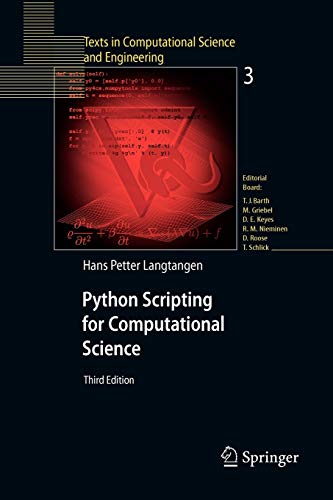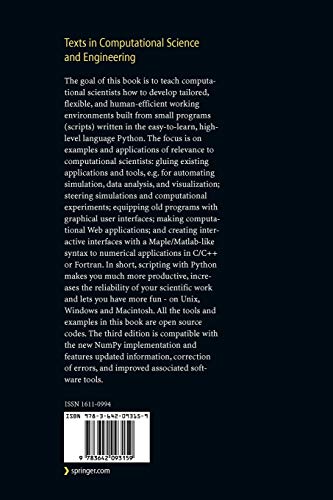Customer Services
Copyright © 2025 Desertcart Holdings Limited
Desert Online General Trading LLC
Dubai, United Arab Emirates




Python Scripting for Computational Science (Texts in Computational Science and Engineering, 3)
P**A
A must have if you use python for scientific purposes.
This book is fantastic. The first third is dedicated to basic Numpy and "daily" operations that engineers and scientists encounter when working with Python, so it resembles a lot to any Numpy/Python book. Nothing "new".The other third, however, is dedicated to GUI programming and integration with Scientific Software. It is full of very useful examples that are not difficult to replicate/modify for your needs.It also addresses more advanced GUI programming using Canvas, C/C++ integration, efficiency, and other subjects I haven't read yet. If you ask me, it has everything I need. And man, when you find yourself without internet connection and *need* to make something work, books can really save you. True story.5 stars for this one.
P**H
a solid reference
I bought this book, just for a couple of the chapters, but i found myself using more of this book then i expected, and reading all the chapters(even the fortran stuff). I found this book better then all my other "scientific python" books, in that my other books really built toyish apps. This book is meant for people doing production computational science work in python. It doesn't have much btw on super computer's programming and python, aside from a lot on how to integrate c/c++/fortan libraries(i.e. anyone doing major work in python probably is integrating to things like Tesla/Hadoop/mpi ... etc ... and the book didn't go to that level).
A**R
Excellent Text and Reference!
As an intermediate Python programmer, this excellent book has become my go to reference for useful intermediate and advanced techniques that I can locate and learn quickly. The writing is clear and not overly verbose. In addition to a wide array of numerical and scientific examples, the book is helpful for a wide range of programming issues, such as gluing together disparate legacy applications, interfacing to C++, regression testing numerical code, building GUI's, web programming, etc.
J**K
A really great reference
Great reference and well written with excellent examples.
A**R
Five Stars
Exactly what i needed and help me out.
W**O
Great
The book is great
G**N
*The* reference for folks who work with Matlab
I'm giving this book five stars because it was basically written for me. I don't mean that literally, of course. I say that because the usual methods of googling for answers and reading the manual do not work when you are trying to push the limits of what a tool is capable of doing. I do numerical computations for a variety of things -- finding patterns in large data sets, automating data collection and analysis, converting raw serial output into convenient CSV, plotting multidimensional datasets etc. Over the years, I have collected a large number of productivity habits with Matlab, which allows me to do ridiculously convoluted things in a short period of time. You just have to read the introduction of any Python manual to understand why I am switching from Matlab to Python. The problem is -- what will replace all these productivity habits? They need to be replaced with "Pythonic" habits, something that can take years of practice.The beauty about Langtangen's book is that it runs through every one of those techniques. Instead of giving a basic example (what your google search would have provided) or a complete list of, ahem, useless techniques (what the manual would have provided), you get exactly what a seasoned data analyst needs to know to get moving with state-of-the-art commands. The author also discusses optimizations and alternatives in each chapter.The book is also the best source for explaining *why* NumPy should be used by people working with large datasets. Folks love to create toolkits for Python, but some of these are a list of non-intuitive shortcuts that don't provide a substantial improvement over basic Python. Langtangen goes through the pain of explaining the benefits of the package (chapter 4.1.4), so that you can decide for yourself if NumPy is useful for your application.I will not comment on the parts of the book that deal with C and FORTRAN integration because I leave that to more able programmers. I also will not comment on the extensive GUI building chapters because I do not build GUIs. I will point out, though, that I have derived full value out of this book simply by reading, and re-reading chapters 2, 3, 4 and 8. Some will argue that there is too much "basic Python" in these chapters for the whole to be considered advanced computational science -- my opinion is that even when the author describes "basic Python", his examples and intuition make it so that even one who has read a couple of reference books cover-to-cover will learn something about using "basic Python" to perform numerical analysis in a more efficient way. In fact, the book is a testament to doing really convoluted things in a really compact and elegant manner!
R**H
Outstanding introduction to Python and Numpy
I've bought what seems to (my wife) be every Python book out there and I can't tell you how sick I am of spam, spam, spam code! (trivial and obfuscated Python code examples with a common theme focused around one Monty Python skit or another...) Spam code seems to prevail in other Python books.Here finally is a book with code examples that are very clear, are immediately useful to the serious programmer and filled with real life discourse on relative performance differences between Python and other languages that have a reputation for speed. There are clear examples of 'number crunching', producing images and even video animations, hooks into other scientific packages such as MathLab, etc.If you are interested in really learning Python, want to come away from an hour or twos worth of coding experience with a module or two that you can use tomorrow and are not interested in code examples extolling Monty Python silliness, then this is the book for you.While this book is about twice as expensive as many of my other Python books, I wish I had purchased this one first. Even though I've been using Python, seemingly every day, for two years, I kept finding nuggets in this book with what seemed to be every turn of the page. My focus right now is processing extremely large data sets of binary data but I'll soon be looking at image processing and I know I'll be reaching for this book over and over again. Don't hesitate! Just buy the book!
P**R
About the book
I don't think it is a right choice for a beginner like me. In fact, I don't think the chapters are well organised and the examples for practice are not good enough.
R**0
Interessante, mah
Il libro e' interessante: sono molti gli argomenti trattati su come scrivere codice numerico, varie librerie sia in Python sia per legare Python a Fortran o C. Purtroppo il codice usa idiomi in generale vecchi e relativamente fuori standard, sembra davvero codice scritto da qualcuno che di mestiere fa altro. Il che fa pensare che questo libro sia pensato per chi di mestiere fa altro (come prevedibile dal titolo). Per queste persone vale sicuramente la pena di essere preso per la carrellata di tecnologie di interesse che fa. Purtroppo tende a sviluppare una libreria custom di utilita' per fare esempi e simili, il che e' di utilita' limitata per chi poi il codice lo deve scrivere e usare (tipicamente una libreria introdotta in un libro e non affermatasi per selezione naturale della comunita' open source e' parecchio sotto gli standard di quello che si trova in giro).
M**L
Enlaces a las descargas de los programas no funcionan
Debido a lo cual el libro se convierte en muy poco util y he tenido, muy a mi pesar, que devolverlo
L**C
Un des meilleurs bouquins sur les usages scientifiques avancés de python, tout en permettant une initiation aux débutants
Un des meilleurs bouquins sur les usages scientifiques avancés de python, tout en permettant une initiation aux débutants.Et je compare avec 8 autres titres (dont peu en français d'un niveau valable), sans compter 4 titres supplémentaires sur les traitements geospatial, texte, PyQt, matplotlib et visualisation scientifique en général.
Trustpilot
2 weeks ago
2 months ago